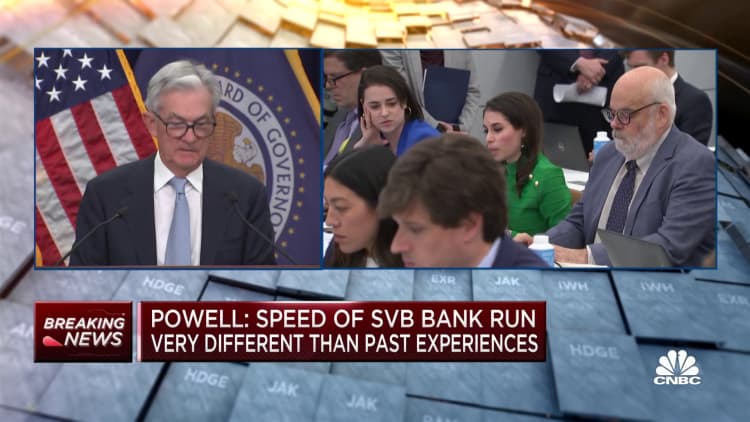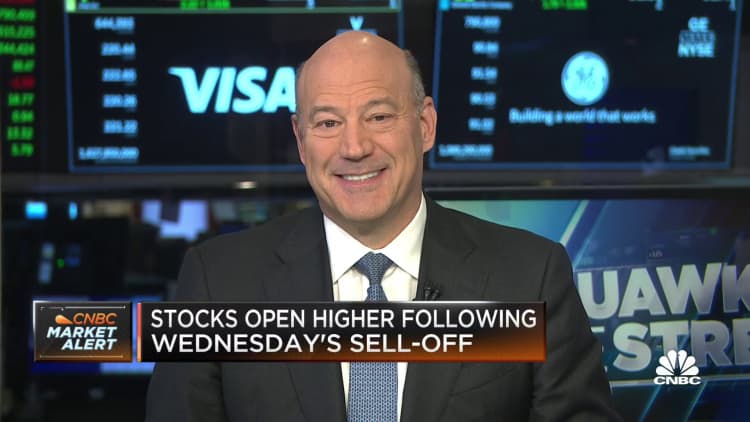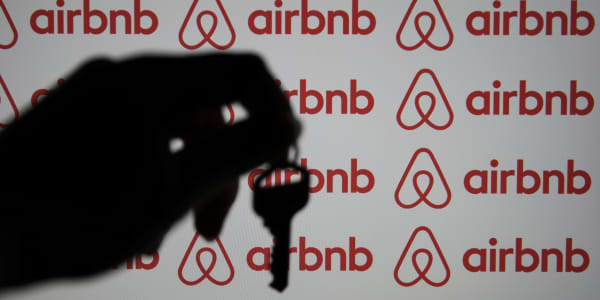
The market now has its answer about whether the Fed remains as focused on inflation as financial sector risks: a quarter-percentage point rate hike in the face of bank failures, the potential for at least one more rate hike later this year and, at least according to Fed Chair Jerome Powell, no chance of a rate cut in 2023 regardless of what traders think. The Fed may be nearing the end of its rate hikes, but for now, the fight against inflation continues, and unequivocally describing yesterday's Powell-speak as either dovish or hawkish isn't so easy. The bottom line is that the Fed will need more evidence to be convinced that the banking sector issues alone can do the central bank's disinflationary work for it.
The reason for the continued inflation focus, more than anything else, was always in plain sight: the job market is still too hot and wage growth, while cooling, hasn't cooled enough for comfort.
Fed Chair Powell's focus on the labor market has been consistent in the months leading up to Wednesday's rate hike decision, and when asked at the post-FOMC meeting press conference whether the central bank considered a pause in rate hikes given the concerns about global financial system fragility, his initial response went straight to the labor market.
"Labor market data came in stronger than expected," Powell said.
While wage growth shows some signs of easing, and Powell noted that the upward pressure on supply and demand in the job market will ease over time, he added that there are not enough signs of progress in the key non-housing services sector inflation being driven by labor conditions. "That's 56% percent of the index and the story is pretty much same ... the data we got pointed to stronger inflation," he said.
Of course, all that could change, and in attempting to balance market concerns about the banking sector with inflation, Powell noted that the Fed does expect tighter lending standards to slow the economy. The Fed chair pointed to the "fair amount of research" on tighter credit standards, but added it is too soon to know how this banking sector shift will influence economic growth.
"It's too early to say, really, whether these events have had much of an effect," said Powell. "I do still think though that there's, there's a pathway to [a soft landing]. I think that pathway still exists, and, you know, we're certainly trying to find it."
There were other factors at plat in the market reaction to the FOMC, with Janet Yellen speaking at the same time as Powell and saying there is no current planning for a wider move to insure deposits across banks. Stocks were trading on Thursday morning with relative bullishness based on the relationship between rate hikes and risk-on equities trading, and one day's trading action in retrospect can amount to no more than a sell on the news, whatever the news is, kind of event — especially for a stock market that has been resilient this year, if shaken, by both the Fed and the sudden banking crisis.
"History tells us that durable turning points for markets tend to arrive once investors begin to anticipate interest rate cuts and a trough in economic activity and corporate earnings, but the Fed's actions and analysis of the economy suggest these conditions are not yet fully in place," UBS's chief investment office wrote in a note on Thursday.
The 500-point slide in the Dow Jones Industrial Average after the Powell press conference may imply that longer term, the market left the FOMC day more concerned that higher rates and tighter banks in combination will exert too much pressure on the economy and Powell won't find his way to avoiding a hard landing.
If it wasn't exactly a hawkish Fed, while the FOMC language and Powell's words downgraded the likelihood of more rate hikes, the Fed also escalated its language related to inflation risk relative to the last meeting, and labor economists are not surprised that the Fed remains focused on the imbalance between jobs and job seekers.
Last weeks' Atlanta Fed data, the latest read from the labor market, show that wage growth for job switchers was steady at a high rate in February, and actually reaccelerated for job stayers after appearing to stabilize in December and January.
The moderation suggests that the market for new hires is cooling off, but the continued strength of job stayer wage growth suggests the overall labor market remains hot, said Nick Heyman, economic research director at Indeed.
That data came on the heels of the February nonfarm payroll report from the week before, which was judged a modest positive by the market in the softening wage gains, but which Glassdoor chief economist Aaron Terrazas described as "a little bit of an economics Rorschach test."
"If you wanted to see a still-strong labor market, you focused on the payroll gains; if you wanted to see a softening labor market, you focused on the trend in average wages. The most recent Atlanta Fed wage data suggest that the slowdown in average wages we saw in the 'jobs report' was more likely a statistical mirage — driven by higher wage workers being laid off, and lower wage workers still encountering opportunities for upward mobility. All together, the February wage data point to a changing labor market more than a slowing labor market."
The labor market is moving in the direction the Fed wants, just not fast enough. Intense hiring pressure has eased, and starting with the fourth quarter of last year, "a lot of companies had hit their breaking point when it came to matching wage increases," said Ron Hetrick, senior labor economist at Lightcast. Some made the decision to "survive" with a smaller staff, he added.
"The big concern is still that the number of people filing for unemployment, although it had a couple small gains, just turned back down again. I think wages will remain sticky as there are still a lot of job openings for lower paid workers which will make it difficult to scale anything back," Hetrick said.
Wage growth percentages remain well above historical averages. "If the goal is to see those percentages in line with more recent history ... there is a lot of work to be done," Hetrick said.
It isn't only labor inflation that has bedeviled the Fed. Recent revisions to monthly CPI data show that even where the most progress has been made in bringing prices down, the progress wasn't quite as strong as initially marked down. But Powell's theory all along has been that only by loosening up the job market and bringing down wage gains can you get a hold of core services inflation, ex-housing. That hasn't changed. Bringing up unemployment by roughly one percentage point, which is the Fed's aim for this year, is a goal the central bank won't relent on. But engineering a one percent increase in unemployment is considered by many in the market to be an-almost "Goldilocks"-like scenario for job losses, a goal the Fed would need to "get away with."

This job market is unique, defined by tighter supply conditions with structural underpinnings that will last beyond any short-term pandemic related swings in hiring, and that helps to make the argument that pressure can be applied to labor without it cracking. But that now becomes part of the larger dilemma for the central bank in its effort to do just enough damage to the economy without a sharp recession amid the banking sector problems. The CNBC Fed Survey before the FOMC showed that the vast majority of economists and money managers expected the 25 basis point hike, but they were split 50-50 on whether going through with it was right.
If the market isn't buying one thing Powell said, it's that rate cuts aren't coming, but the reasons for that conviction may have shifted. Earlier this year, stocks took off on the premise that the Fed might get its way with a soft landing and be able to end its rate-hiking cycle sooner than expected. Now if the rate cuts are coming, it may be because conditions deteriorate more than even the Fed wants. The central bank's zeroing in on labor is inextricably linked to the broader risk of tipping the economy into recession. It just wasn't linked to the new unpredictable factors in the credit market until now.
The latest initial jobless claims data on Thursday didn't show any notable slowdown in the hot labor market, another indication that its continued strength will continue to pressure the Fed. "The consensus view is that the labor market is going to weaken in the spring. Well, it is now spring and the last weekly reading for the winter posted another surprise decline. If hiring doesn't show meaningful signs of slowing down soon, Wall Street might have to price in one more rate rise for the May 3 FOMC meeting," wrote Edward Moya, senior market analyst at trading firm Oanda, on Thursday.
Wall Street has been at work measuring the rate hike equivalent of tighter credit in recent weeks, with Goldman Sachs pegging it at 25 to 50 basis points, and an overall economic effect somewhere between the dotcom crash tightening and the financial crisis — though notably, from an already tighter starting point. In his comments, Powell pegged it at around at least 25 basis points. The banks and the Fed could end up getting it just right. But there are two worse scenarios related to the new unknowns. If the financial system stress is manageable to minimal, the view taken by Action Economics, the Fed will have to increase in May and even another quarter point in June, as inflation remains too high from the FOMC view. Or, if a clampdown on lending by banks turns out to be an even blunter tool than what the Fed has at its disposal in rate hikes and balance sheet reductions, it could ultimately outrun and outgun the central bank when it comes to disinflation, newer forces in the financial system doing the Fed's work for it, or at least compounding it — before the Fed has the chance to declare its work done.
"We're almost getting to a point right now where he is outsourcing monetary policy," said former National Economic Council director Gary Cohn about Powell on Thursday morning. Cohn, who has been in the soft landing camp, said he isn't ready to back down from that view, but, "Now that the Fed has lost control, it's more difficult."







